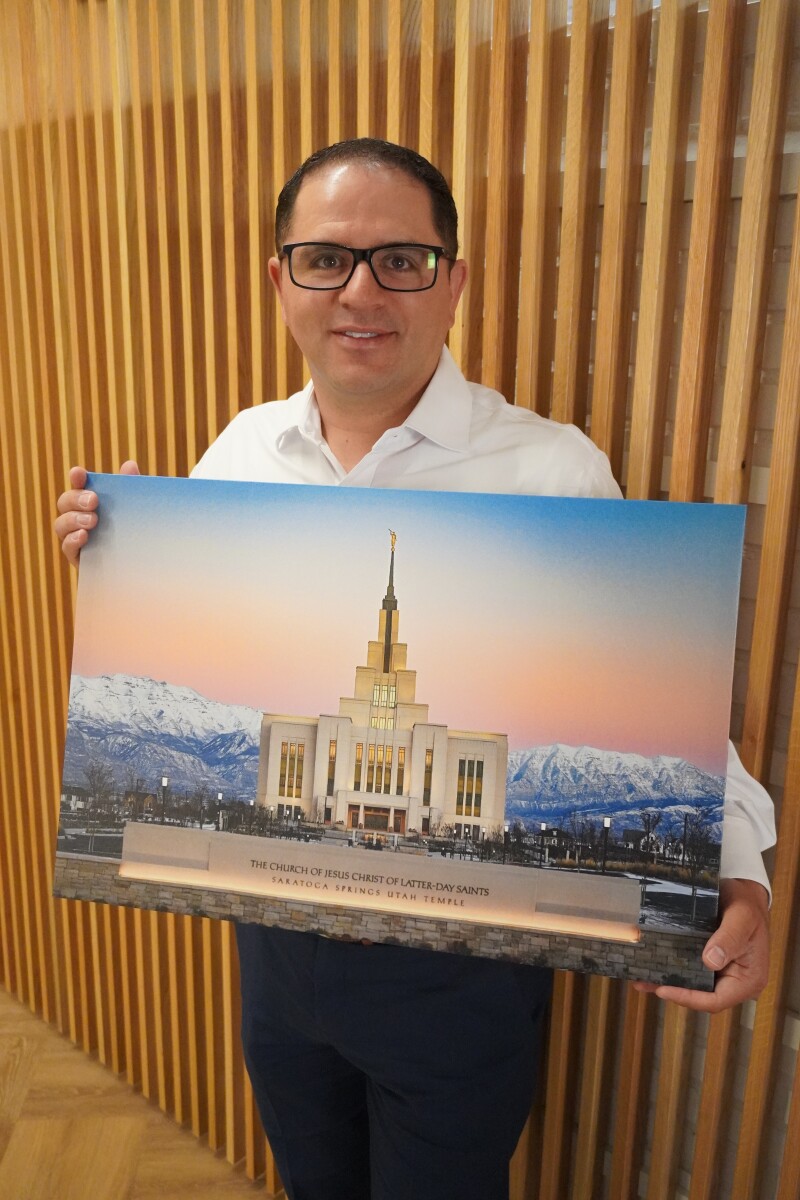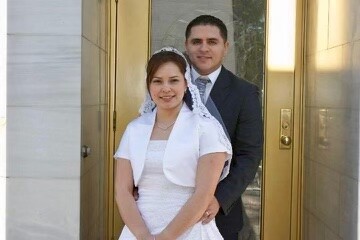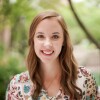Eduardo Maradiaga kept having the impression that he needed to take a picture of the Saratoga Springs Utah Temple—and he had no idea why.
“I felt something in my heart, in my mind, that constantly was a little reminder to me: ‘You need to take a picture of the temple. You need to go. You need to go. You need to go.’ Every day I felt that,” he recalls.

He told his wife about the feeling he’d been having, and she gave him the encouragement to act on it. Although the temple was still awaiting its open house and dedication the following year, the building’s exterior was complete, and the grounds were quiet. So a few weeks later, at about 5:00 p.m. on a chilly November night in 2022, Eduardo gathered his camera equipment from his basement apartment and drove to the newly constructed temple located just five minutes away from where he lived. Setting up his tripod, he looked through his camera and carefully framed the temple against a backdrop of snow-capped mountain peaks.
“It was a perfect time when the sun was [setting] in the mountains behind the temple, and you could see the beautiful colors—pink, blue, red, yellow. . . . I got a beautiful shot,” he says.
Eduardo didn’t know it then, but that photo was about to go on a journey that would give him and his family hope as they started new lives in the US. And after leaving everything behind in their home country of Honduras, they needed that hope more than ever.
Home in Honduras

Eduardo never had much as a boy when it came to material possessions; he was helping provide for the family at just five years old. Waking up at 4:30 a.m. every morning, he and his grandma quickly got to work making dough for tortillas, the comforting aroma of flour, salt, and fat filling the small wooden house where they lived.
Afterward, they sold the tortillas to their neighbors before starting the process all over again the following morning. But while they lived day to day, Eduardo was rich in the things that mattered most.
“I had a good childhood because [my grandma taught] me how to be a good person, how to grow and choose the right,” he says. Those teachings helped him when gangs and drug cartels approached him in the dangerous neighborhood he grew up in. “When I was a kid, I remember they invited me to sell drugs or to try alcohol. And every time, I said no,” he says. “My grandma [taught] me how to be a good kid.” He was grateful to have that guidance as a child—his friends who chose perilous paths were killed by the gangs and cartels.
It was in his youth that Eduardo was also introduced to the gospel. It all began, he says, when his father was walking down the street one Monday in Tegucigalpa, Honduras, and saw the missionaries playing basketball. A lover of the sport, his father stopped to watch. The missionaries noticed and invited him to play—and he couldn’t pass up the opportunity. But that pickup game turned into something more meaningful than a little friendly competition, as the missionaries later asked Eduardo’s father if they could share the gospel with him. Eduardo recalls his family meeting with the missionaries in their home and how his life changed forever.

“When I received the missionaries, that opened my mind. I felt something very special in my heart,” he says. “And when I [found] the Church, my life [became] completely different. I found hope . . . and I started to have new friends in the Church. . . . For me, the Church is everything. It is the most important [thing] in my life.”
So at age 13, on December 28, 1995, Eduardo was baptized. Other members of his family would join the Church as well, including his father and brothers—and just a handful of years later, Eduardo served as a missionary in Ecuador. “I wanted to be a missionary because the missionaries were my heroes when I was a young man. So I thought, ‘Someday I’m going to be a missionary,’” he says.
On his mission, Eduardo’s life was different from what he was accustomed to—and not simply because of his new schedule. “Before this I had not had a real bed; I had never had my own room to sleep [in],” he recalls. But more importantly, he loved learning and growing in new ways as he preached the gospel to many people.
Following his mission, Eduardo went to school studying marketing and business, and he had an idea for a business he could start.
“At that time, nobody sold accessories and gadgets in my country, so I was pretty new in the market. And I realized that people need to protect their phones. . . . If you break your phone [in the US], you . . . [can] replace your phone completely,” he explains. “But in my country, they don’t have a lot of money to buy phones, so they need to protect [them].”
So Eduardo started a business selling cell phone cases, and the company took off. Before long he was managing multiple stores, located in some of the best shopping centers in Honduras. He also began doing business in the US. But despite his success, there was still one thing Eduardo was looking for in life: his eternal companion.
Starting a Family
Eduardo was at institute when he first saw Giselle Alonzo, who would later become his wife. He knew right away that she was the one he was looking for. “When I saw this beautiful lady, I thought, ‘She’s the [one].’ I fell in love with my wife from the first moment I saw her,” he says.

The stars didn’t align right away, though—Eduardo didn’t get the chance to talk to Giselle that day. Realizing that she’d caught his attention, she suddenly felt nervous and left before he could approach her. But he wasn’t about to give up, so he quickly asked a fellow institute student if she knew anything about her. Through that student, he was able to get Giselle’s home phone number, and he dialed it the very next day.
“You know who answered?” Eduardo says, laughing. “Her mother. And she starts to interview [me]—who I am, what I do.”
Luckily, he passed the initial test—and the next one, when Giselle agreed to go out with him. After eight months of dating, they were married civilly on December 4, 2010. Since there were no temples in Honduras at the time, a few days later they traveled nine hours to be sealed in the Guatemala City Guatemala Temple.
Together, Eduardo and Giselle served faithfully in the Church and had two children. Everything seemed to be going perfectly—but then the pandemic hit, and everything changed.
Starting Over
When COVID-19 impacted Honduras, Eduardo’s world turned upside down—starting with the fact that he had to close his business due to the pandemic.
“I think that was the [hardest] year in my life. When I was a child, I knew [life] was kind of hard, but I didn’t even know that I was poor because I didn’t even know [what it was to have] money. . . . But in 2020, everything was different because I already had money,” he recalls.
Unfortunately, the situation only grew worse, as his grandmother, father, and brothers all got COVID-19. His father’s case was especially dire.
“My father [was] sick for almost seven months, and I tried to save him, but our health system is terrible in my country,” Eduardo says. “I spent a lot of money to try to save him, and I spent all my physical energy to try to save him . . . but I [couldn’t]. He was born September 21, 1958, . . . and he died the same day that he was born in 2020. I miss my father so much. He’s my hero.”
In the midst of his grief, Eduardo’s stores and home were robbed, and continued threats against his family led him to feel that they needed to relocate. The situation became so severe that, one night, Eduardo and his family fled their home with just two suitcases. They bought plane tickets to Utah in hopes of starting a new life there, and as a precaution they told no one of their departure. When they arrived, Eduardo, who had been serving as bishop, called his stake president back home and told him that he had left.
Throughout the many unknowns he faced, Eduardo held fast to his faith. “I prayed a lot,” he explains. “I said to myself, ‘Well, we need to keep going. We need to do [our] best. You have a family, you have a beautiful wife, you have your kids. So you need to keep going.’”

Miracles soon started coming their way. Within a week of arriving in Utah, and after fervent prayer, Eduardo and Giselle found a basement apartment in Saratoga Springs that they hoped to live in. Walking there the very next day, they discovered that the owner of the house, who served a mission in Mexico, spoke Spanish, which was a great blessing as Eduardo and Giselle didn’t know English at the time. The Maradiagas have been living there ever since.
Doing whatever he could to make money, Eduardo started taking on a number of jobs, including detailing cars, cleaning houses, installing blinds, and doing photography, which he had previously taken some courses in. So when he took the photo of the Saratoga Springs Utah Temple and showed it to his wife, an idea struck her: he should sell it to Deseret Book.
“I told my wife, ‘I don’t think they’re going to hire me. They’re [not] going to buy my picture. Just think about how many photographers are in Utah—a lot of photographers.’ And I told my wife, ‘Maybe the Church has their own photographer . . . for the temples,’” he recalls.
But Giselle was persistent, so Eduardo eventually took his picture to a Deseret Book store in American Fork and showed it to the manager, who recommended he submit it online. Filling out the application, he hoped for the best—and was disappointed. He received an email saying his submission was rejected.

Instead of moving on, Eduardo replied to the email and shared part of his story. “We just arrived in this beautiful country,” he wrote. “We have struggled to have opportunities, but all the doors are still closing.”
When Dallan Wright, Fine Art Category Manager at Deseret Book, received the emailed reply, he decided to reevaluate the situation. He’d initially turned down the photo without looking at it closely: Since 2018 he’s received over 750 art submissions, and he estimates only 2 percent end up in stores. Plus, he rarely accepts photos of temples from new artists.
“There are so many temples in the world now, and so many photographers capturing those temples, that it’s hard to find a temple image compelling enough to go through the process of licensing or purchasing one single temple. I’ve found it easier to work with a couple of vendors who have connections to a wide variety of temple art,” he says.
But after reading about Eduardo’s background, Dallan decided to look again.
“If the art isn’t good, I can’t bring it in even if the story is incredible. Regardless, I did go back to the email and took a closer look at the image. The sky was nice, the mountains lovely, and the temple . . . well, I was an idiot! I did not even look close enough to notice that this was the undedicated Saratoga Springs Temple, of which I [had] zero images. Not a one. I hadn’t even bothered asking for one yet because photographers in the past have rarely had images at this stage of construction,” he says.
So Dallan emailed Eduardo with the good news—his work was accepted at Deseret Book. For Eduardo, that message meant everything. “Oh, my goodness. I started to cry because for me, it’s wonderful,” he remembers. “And I called my wife and told her, ‘Hey, they said yes!’”
Eduardo quickly replied to Dallan’s email: “Right now when I read your email, my wife and I are crying with happiness.”
The Most Important Building

Since selling his photo at Deseret Book, Eduardo has started doing photography for families and he is always looking for ways to progress in a new country. His stake president, Jordan Erickson, has seen that determination in action.
“He’s always thinking of . . . ‘How do I provide for my family?’” President Erickson says. “Whether it’s window washing or shooting a picture of the temple, . . . [he has] that entrepreneurial mind that never stops and never sleeps, especially in a new country. That, coupled with his drive and his testimony in advancing the work—he just knows that it will all work out.”
Eduardo has been called as a high councilor in his stake; his responsibilities include working with EnglishConnect, a program provided by the Church that helps individuals develop their English skills and self-reliance. President Erickson says that Eduardo has been a phenomenal representative in that capacity, and that no matter how he’s serving in the Church, Eduardo gives it his all.
“He always shows up,” President Erickson says. “He’s not just doing the minimum. He’s thinking, ‘How can I advance and move the work forward at all times?’ Whether that’s an assignment through the high council, or it’s a ward activity, or it’s something that his wife’s involved with, Brother Maradiaga just shows up.”
Giselle also does her utmost for her family and the Church; while she and Eduardo are busy learning English now, she hopes to eventually work as a pharmacist in Utah, as she did in Honduras. She also serves in the Primary in her ward.

While the road ahead for the Maradiagas may seem long, selling the photo of the Saratoga Springs Utah Temple is at least a step in the right direction. But it’s more than a financial blessing for their family: Whenever Eduardo is in one of the stores that sells his work, he says a special feeling comes over him. At the heart of that feeling is a love he holds for the building he captured forever on that wintry November night last year—and more than anything, he hopes that when others see his photography, it brings them that same feeling of love.
“For me, the temple is the most important building for the Lord on the earth, so it’s very special. And now the Saratoga Springs Temple is very special for me and my family. And when I put the picture in Deseret Book, I think [of how] it will mean something special for every single person that is going to buy it. This temple is for the whole area of Saratoga Springs,” he says. “We are very excited.”

